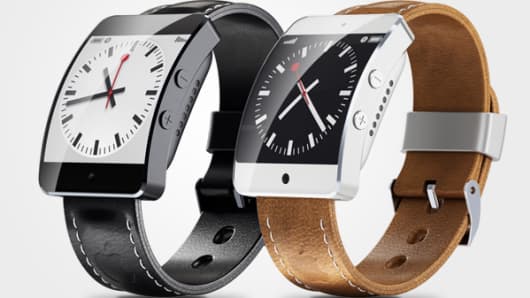The Galaxy Gear, Sony's SmartWatch 2 and Google's recently acquired WIMM Labs—who is naming these?!—all feature the same fatal design flaw: a square display screen. Meanwhile, the popular wrist tech that many people are already wearing—the FuelBand, Fitbit One, and Jawbone Up—are narrow bands. The Fitbit and Up don't have displays at all.
Taking cues from this consumer behavior, the winning iWatch will smoothly integrate its display into the band. Picture a bangle with a screen—a screen that is invisible when the band is on standby. Just like this Apple iWatch patent diagram.
Remember, Tim Cook wears and admires the FuelBand and recently hired one of its key developers to work on the iWatch. Of course, it will be inspired by the FuelBand.
This approach to design will result in a device that looks cool and classy enough to wear all the time. And with that, the iWatch can become an integral extension of your iOS life:
• Communications: Receive iMessages, notifications, phone calls and FaceTime.
• Transactions: Use Passbook on your band—scan anything from a Target or Starbucks card, to movie or airplane tickets.
• Television: Enable hand-gestures that control Apple TV—or the eventual iTV—a la Xbox Kinect, to which the iRing alluded in March.
• Internet of things: Lock and unlock your door with a swipe of the wrist, using the Lockitron app; change songs on your Bluetooth or Airplay speakers; control your Nest thermostats.
• Health-quantified self: Hundreds of useful mobile apps let you monitor jogs, hikes, steps, and bike rides, quality of sleep, heart rate, blood pressure, glucose and more. You will no longer need your phone, FuelBand, Up or Fitbit to track yourself. The band will monitor you 24/7 and communicate seamlessly with the apps on your phone. This health category is expected to account for 65 percent of the aforementioned $6 billion dollar wearables market.
• Customization: People will be able—and more willing—to buy cases for their new band, adorning the high-functioning fashion accessory with leather and jewels.
We're too tied to our smartphones, always fishing them out of pockets and bags, locating the app we need and pecking away. It will be liberating when our most persistent technological interactions become less involved, more intuitive and essentially invisible.
Redefining the way we use a traditional product is what Apple does best. The iPhone redefined phones. The iPad redefined computers.
The iWatch will redefine the watch, the Galaxy Gear, and the way we interact with the world.
—Jason Stein is the founder of social media agency Laundry Service, and a partner in Windforce Ventures, a venture capital firm focused on social and mobile. Stein owns shares of Apple. Tweet him at @jasonwstein.





